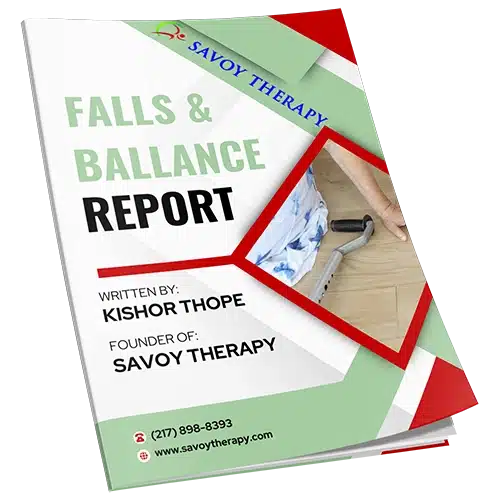A balance disorder is a condition that makes you feel unsteady or dizzy.
If you are standing, sitting, or lying down, you might feel as if you are moving, spinning, or floating. If you are walking, you might suddenly feel as if you are tipping over.
What Is Our Approach To Treating Falls & Balance
As we get older, the risk of falls and fall-related injuries increases. In fact, every 11 seconds, an older adult is taken to the ER with a life-threatening injury due to a fall.
Falls are often thought of as accidents – something that just happens as we age. However, some signs and symptoms indicate an increased risk of falling. These include slowing down walking speed, taking shorter steps, or adopting a shuffling gait where the feet aren’t fully picked up. Walking may become slower, and the person might lean forward or rely on walls or stable furniture for support as they move.
These symptoms signal that fall risk is increasing. If we can identify someone at this stage, the impact of therapy can be profound.
Before a fall occurs, other changes are often noticeable. People may start venturing out less frequently. Even within their own home, they might avoid certain areas, such as the basement or stairs, due to a fear of falling. This fear can lead to a more confined lifestyle, where movement is limited to just one floor of the house—often between the bedroom, kitchen, and living room. Over time, life becomes increasingly restricted.
In such cases, physical therapy and occupational therapy play a critical role in identifying the reasons behind the increased fall risk, such as weakness or slowed movement. These therapies can be tailored to the individual’s needs to help them regain strength, balance, and, most importantly, confidence. The ultimate goal is to restore their sense of freedom and independence.
What are the symptoms of a balance disorder?
If you have a balance disorder, you may stagger when you try to walk, or teeter or fall when you try to stand up. You might experience other symptoms such as:
- Dizziness or vertigo (a spinning sensation)
- Falling or feeling as if you are going to fall
- Lightheadedness, faintness, or a floating sensation
- Blurred vision
- Confusion or disorientation.
Other symptoms might include nausea and vomiting, changes in heart rate and blood pressure, and fear, anxiety, or panic.
Symptoms may come and go over short time periods or last for a long time, and can lead to fatigue and depression.
Request A Call Back from a physical therapist
If you’re not quite ready to book an appointment yet and have some questions you would like answered first, click the link below to complete a form to get the conversation started.


What causes balance disorders?
There are many causes of balance problems, such as medications, ear infections, a head injury, or anything else that affects the inner ear or brain. Low blood pressure can lead to dizziness when you stand up too quickly. Problems that affect the skeletal or visual systems, such as arthritis or eye muscle imbalance, can also cause balance disorders. Your risk of having balance problems increases as you get older.
Unfortunately, many balance disorders start suddenly and with no obvious cause.
Common Diagnoses We Work With Include:
- Central Nervous System Disorders
- Neuropathy
- Age-Related Balance Dysfunction
- Oculomotor (Visual) Dysfunction
- Benign Paroxysmal Positional Vertigo (BPPV)
- Labyrinthitis
- Ménière’s Disease
- Vestibular Neuronitis
- Muscle Atrophy
- Nerve Injuries
Treatment for Balance Disorders
There are more than a dozen causes of dizziness and many reasons why you might have difficulty with your balance.
Treatment of balance & dizziness disorders can be very complex. Nevertheless, we have helped numerous residents in the community cope with or recover from conditions that cause balance disorders.
The first thing your doctor will do if you have a balance problem is determine if another health condition or a medication is to blame. If so, your doctor will treat the condition, suggest a different medication, or in many cases, refer you to one of our balance disorder experts here at Savoy Therapy.
Need To Know More About Cost and Availability?
If you’d like to find out more information about the cost and availability of our services click the button below to complete a short form, a member our team will then reach out.
How Our Physical Therapists Can Help
Physical therapist directed treatment can assist patients with balance disorders in a number of ways. As experts in the evaluation and treatment of movement, muscle, joint, and nervous system disorders, our physical therapists can prescribe and implement a variety of treatments including:
- Coordination Exercises
- Proprioception Exercises
- Strengthening Exercises
- Stretching and Range of Motion Exercises
- Posture Exercises
- Retraining of the Inner Ear
- Visual Tracking Training
Education is Therapy
The most important part of treating a balance disorder is understanding your diagnosis, the cause of the problem, and how to manage it. That’s why we place great emphasis on patient education and coordination of care with your referring physician.
Download Our FREE Report
Are falls and balance starting to become an ever-present and worrying presence in your life or the life of someone you care about?
Download our free falls and balance report that suggests why you could be suffering from this problem and what natural solutions are available.
There is always something that can be done to improve your situation, take the first step towards a healthier, more confident you.

